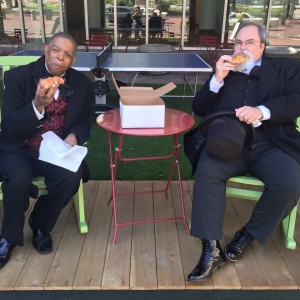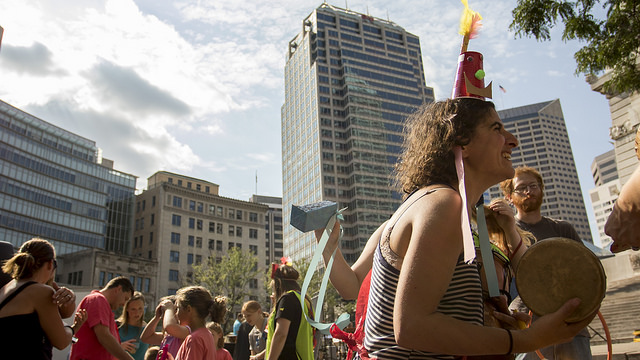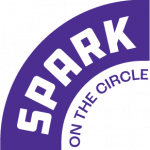We at Big Car are teaming up with Downtown Indy and the City of Indianapolis — with support from the Capital Improvement Board and the Indiana War Memorials Commission— to spark Monument Circle with human-scale activities like games, live music, artmaking, and socializing in a comfortable place. We’re based from the southwest quadrant in front of the Emmis.
WALKING WEDNESDAYS: Public Art Crawl
We at Big Car are teaming up with Downtown Indy and the City of Indianapolis — with support from the Capital Improvement Board and the Indiana War Memorials Commission— to spark Monument Circle with human-scale activities like games, live music, artmaking, and socializing in a comfortable place. We’re based from the southwest quadrant in front of the Emmis.
Spark by the Numbers
2015 SPARK By the Numbers by Big Car
We’ve pulled numbers together from surveys and counts from Spark. Check them out above or download a one sheet here.
Sparking (living) history with the ghosts of Monument Circle’s past
By Rob Peoni, Spark writer in residence
If you lunch on Monument Circle on Thursdays or linger for a bit after the day’s final whistle blows, you may notice a couple of people who appear out of place. It’s not the people in green construction vests employing arts activities rather than repairing stoplights. It’s not even the Sasquatch circling a Wagon of Wonders. Well, they may be out of place too, but I’m talking about the woman and man perspiring in the early fall sun, outfitted in conservative, 19th century formal attire.
On the afternoon of my visit, the two sore thumbs were former Indiana First Lady Esther Ray Brown and former governor Oliver P. Morton (above). Or, rather, the ghosts of Eshther Ray Brown and former governor Oliver P. Morton. “They call us ghosts,” Brown says of the organizers behind the Spark Monument Circle programming. “Yes, we’re aware of our time, but we’re also aware of the time that you’re in. So, we don’t have to be so strictly in 1827 or so strictly in the 1860s. We can sort of go back and forth. We’re sort of omniscient in that way.”
Morton and Brown are two historical interpreters on loan from Indiana Historical Society. When he’s not wearing Morton’s signature three-piece suit, the man with the lush, white facial hair is Dan Shockley, I.H.S.’s director of museum theater. His partner-in-crime is Erin Cohenour, an interpreter at I.H.S. and local actress. “At the Historical Society, the actors you meet are in character the entire time that you’re with them,” Shockley says. “Here, we’re really ambassadors for Monument Circle and we’re in and out of character the whole time.”
This flexibility allows Governor Morton to employ his iPhone when the occasional out-of-towner stops to ask for directions. In fact, it’s more often non-natives who take the time to stop and interact with the historical figures. “If you’re from here, you’re probably not going to have a lot of time to stop and talk to us,” Cohenour says of the bustling lunch crowd. “But if you’re traveling and this is leisure for you, you’re going to have all the time in the world to talk with us.”
In addition to Brown and Morton, visitors to Monument Circle may also encounter the ghosts architect Alexander Ralston – responsible for the design of downtown Indy, or John Freeman – an African-American business man who owned a successful restaurant near Monument Circle in the mid-19th century. “We were passing by the Columbia Club and a woman stopped us to ask what we were doing and she was so impressed that we had a John Freeman character,” Cohenour says. “She did a lot of history with Underground Railroad and Indiana Landmarks, and she was so impressed that they had chosen that character. She just felt that he had a really great story to tell.”
Overall the reactions to the ghosts have proved more positive than petrified. While we conducted our interview beneath the shade of one of Big Car’s parklets, a random passer-by called out enthusiastically, “Hello, governor!” Shockley returned the acknowledgment with a wave and a smile.
“Certainly, Governor Morton would’ve been pleased with the monument,” Shockley says. “He is known as the soldier’s friend. Other than Deleware, Indiana sent the most number of soldiers to fight in the civil war. He was known for that, but also known for taking care of them once they came home. So, the fact that there are two statues dedicated to him within a two-block radius of the circle really speaks to the reverence people felt for him while he lived and very much after he passed away.”
For their part, Cohenour and Shockley have embraced the opportunity to get outside the confines of Indiana History Center to interject some history into the community at large.
“People may think this is a permanent fixture,” Shockley says of the Spark programming. “In six more weeks or so, this will be gone. I think once all of this is gone, people are going to realize what the Circle can be. It can be so much more than it is (without Spark). It’s beautiful as it is, but this helps bring people down to the Circle to see the monument, to stop, to read, and to learn something or just marvel at the beauty.”
Ask an Expert sparks Monument Circle with new thought
By Chris Schumerth, Spark writer in residence
During the next several weeks, if you walk or drive by the sidewalk space in front of Emmis Communications on Monument Circle at about noon on Tuesday, you are likely to see a green “Ask an Expert” booth. If you stop, you will enjoy a lunch hour of lively conversation, probably learn a few things about an interesting topic, and maybe even find that you have your own expertise to offer the city of Indianapolis.
That’s what the IUPUI Arts and Humanities Institute hopes for, anyway. Led by IUPUI history professor Jason Kelly, the Institute is currently collaborating with Big Car’s Spark Monument Circle art and placemaking project. “Ask an Expert” both brings experts of various topics and fields to Monument Circle, while also inviting submissions of expertise (or “trade secrets”) from Indianapolis residents, the results of which will be published collectively online.
For example, Kelly is working on his own project called “Rivers of the Anthropocene.” He said the question most people ask him is: what does Anthropocene even mean?
Sounds like a fair question. The term was coined by Russian scientists in the 1960s, and, as Kelly explained, refers to a measurable geological layer of the earth that was significantly influenced by human behavior. Kelly’s project proposes an exploration of international rivers as systems and calls specifically for collaboration between scientists and the humanities.
“It’s going to cost a lot of money to create some of the changes we need to make,” Kelly said. “But Indianapolis can do better.”
But all “Ask an Expert” conversations are not about the Anthropocene. Upcoming topics include “Art Therapy” with Juliet King (September 15), “Christianity and Globalization” with Joseph Tucker Edmonds (September 22), “Art and Anthropology” with Fiona McDonald (September 29), “Women in Politics with Kristy Sheeler” (October 6), and “Science Fiction and Philosophy” with Jason Eberl (October 13).
I sat down this past Tuesday with Dr. Ray Haberski, another IUPUI professor. Like Kelly, Haberski is an intellectual historian, which means he is interested in the history of ideas. The author of a number of books – including Evangelization to the Heart: A Brief History of American Franciscans and Media, God, and War: American Civil Religion since 1945 – Haberski was at the booth to talk about “God and Country.”
As an example of the kind of issues he’s interested in, he brought up Kim Davis, the Kentucky Clerk who was recently jailed for refusing to issue marriage licenses to same-sex couples. Or on the opposite end of the spectrum, he also mentioned the 1954 decision to insert “under God” into the pledge of allegiance.
What is one to do when he or she finds that his or her religious conviction lands opposite a law? Haberski drew a distinction between religious groups and individuals who happen to be religious. “We can’t outlaw ideas,” he said.
Pete Weldy, the Director of Policy and Research at the Department of Education, and Carla Delagarza, a Legislative Assistant, were on their way to lunch at Chipotle from the Statehouse when they stopped in and brought their own expertise to the discussion.
Haberski quickly turned the conversation to the visitors’ interests, one of which was legislative strategy for Indiana’s minority party, the Democrats.
“We try to win by losing correctly,” Delagarza explained. She also said her party works hard at adding amendments to pieces of legislation that they’re opposed to but which are going to pass.
It was Delagarza’s first time stopping in for a Spark program, but she said she had noticed the programming previously, particularly the As You Wish project that invites people to make a wish that artists make true out of materials they have on hand at Spark.
“Ask an Expert” is one of several programs that make up a creative experiment that aims to treat Indianapolis’s Monument Circle as a park. Spark is funded by a $200,000 Our Town grant from the National Endowment for the Arts in addition to support from CICF and The City of Indianapolis. The programming started at the beginning of August and continues through Oct. 16. During that time, you will find activities bustling from 11 a.m. to 8 p.m., seven days a week.
Monumental Parades
Saturday, August 29: experience a sensory parade around the Monument, designed by artist Rebecca Pappas, profiled here (and pictured above).
by Rob Peoni, Spark writer in residence
Conflict abounds in everyday life. We can find a reason to argue over just about anything. Despite this fact, in my thirty years on this planet, I have never heard anyone argue over or disparage parades. They are a universally beloved event.
“I feel interested in parades, because of the porousness between performers and audience,” says choreographer Rebecca Pappas. “When you watch a parade, you could be in the parade. Maybe you were in the parade before. There’s a sense of a really low threshold for participation.”
Pappas recently moved from her previous home of Los Angeles, CA to Indianapolis after accepting a job as a dance professor at Ball State. In LA, Pappas collaborated predominantly with professional dancers and in more traditional, theater settings. However, her interests began to shift in the last several years.
“Within the whole field of dance, there’s an increasing interest and a decreasing sort of wall between ‘that’s real dance and that’s this other thing,’” Pappas says. “There are a lot of galleries presenting dance, and there are a lot of artists – quote, unquote – making movement projects.”
Upon moving to Indianapolis, a friend connected Pappas to Anne Laker, Big Car’s Director of Cultural Programs. They discussed Pappas’ growing interest in public practice art, and her focus on parades. Soon thereafter, Laker approached Pappas with an opportunity to help design parades as part of Spark Monument Circle. “I felt really welcomed by Big Car, and the art-making community in Indianapolis,” Pappas says. “That’s part of what feels really exciting about being in a city that’s more accessible than a city like Los Angeles. … working with Big Car is my way of getting to know my new home and connect with it and bring what I do to this place.”
This Saturday, Spark Monument Circle will host the “five senses parade.” It will feature a series of sensory experiences that Pappas will lead participants through. “Some of them will be movement,” she says. Some of them will be about tasting things or smelling things. Some of them will be about looking at the space in a different way. We’ll all be walking together, but also having private experiences at the same time.”
The five senses parade will begin around 5pm on Saturday, August 29. However, those interested are encouraged to arrive at Monument Circle earlier in the afternoon. Pappas and the Spark crew will be leading participants in a series of smaller sensory experiences between 3 and 5pm. “We’ll be providing a bunch of them, because we know people will dropping in and out,” Pappas says. “We want to as many people as possible to experience the parade.”







